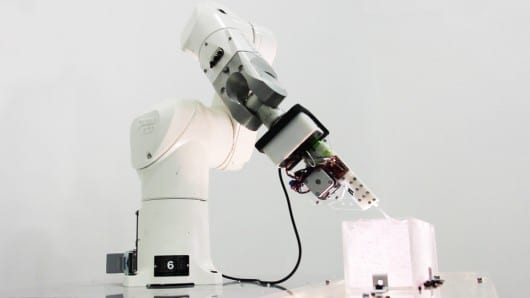
- Image via Wikipedia
Chaos fills battlefields and disaster zones. Artificial intelligence may be better than the natural sort at coping with it
ARMIES have always been divided into officers and grunts. The officers give the orders. The grunts carry them out. But what if the grunts took over and tried to decide among themselves on the best course of action? The limits of human psychology, battlefield communications and (cynics might suggest) the brainpower of the average grunt mean this probably would not work in an army of people. It might, though, work in an army of robots.
Handing battlefield decisions to the collective intelligence of robot soldiers sounds risky, but it is the essence of a research project called ALADDIN. Autonomous Learning Agents for Decentralised Data and Information Networks, to give its full name, is a five-year-old collaboration between BAE Systems, a British defence contractor, the universities of Bristol, Oxford and Southampton, and Imperial College, London. In it, the grunts act as agents, collecting and exchanging information. They then bargain with each other over the best course of action, make a decision and carry it out.
So far, ALADDIN’s researchers have limited themselves to tests that simulate disasters such as earthquakes rather than warfare; saving life, then, rather than taking it. That may make the technology seem less sinister. But disasters are similar to battlefields in their degree of confusion and complexity, and in the consequent unreliability and incompleteness of the information available. What works for disaster relief should therefore also work for conflict. BAE Systems has said that it plans to use some of the results from ALADDIN to improve military logistics, communications and combat-management systems.
War and peace
ALADDIN’s agents—which might include fire alarms in burning buildings, devices carried by emergency services and drones flying over enemy territory—collect and process data using a range of algorithms that form the core of the project. To develop these algorithms the 60 researchers involved used techniques that include game theory (in which agents have to overcome barriers to collaboration in order to get the best outcome), probabilistic modelling (which is employed to predict missing data and reduce uncertainty) and optimisation techniques (which can provide means of making decisions when communications between agents are limited). A number of the algorithms also employ auctions to allocate resources among competing users.
In the case of an earthquake, for instance, the agents bid among themselves to allocate ambulances. This may seem callous, but the bids are based on data about how ill the casualties are at different places. In essence, what is going on is a sophisticated form of triage designed to make best use of the ambulances available. No human egos get in the way. Instead, the groups operating the ambulances loan them to each other on the basis of the bids. The result does seem to be a better allocation of resources than people would make by themselves. In simulations run without the auction, some of the ambulances were left standing idle.
The bidding algorithms can be tweaked to account for changing behaviour and circumstance. Proportional bidding, for instance, allows resources to be shared. If one agent bids twice as much as another for the use of a piece of equipment, the first agent will be given two-thirds of its capability and the second one-third. And, a bit like eBay, deadlines placed on making bids speed the process up.
All of which is very life-affirming when ambulances are being sent to help earthquake victims. The real prize, though, is processing battlefield information. Some 7,000 unmanned aerial vehicles, from small hand-launched devices to big robotic aircraft fitted with laser-guided bombs, are now deployed in Iraq and Afghanistan. Their combined video output this year will be so great that it would take one person four decades to watch it. Next year things will be worse. America is about to deploy drones equipped with a surveillance system called Gorgon Stare. This stitches together images from lots of cameras to provide live video of an area as big as a town. Users will be able to zoom in for a closer look at whatever takes their interest: a particular house, say, or a car.
Related articles
- Rise of the robots and the future of war (guardian.co.uk)









